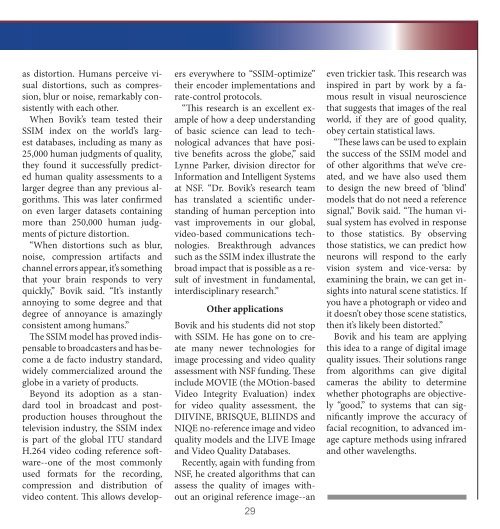October/November 2015 Digital Edition
You also want an ePaper? Increase the reach of your titles
YUMPU automatically turns print PDFs into web optimized ePapers that Google loves.
as distortion. Humans perceive visual<br />
distortions, such as compression,<br />
blur or noise, remarkably consistently<br />
with each other.<br />
When Bovik’s team tested their<br />
SSIM index on the world’s largest<br />
databases, including as many as<br />
25,000 human judgments of quality,<br />
they found it successfully predicted<br />
human quality assessments to a<br />
larger degree than any previous algorithms.<br />
This was later confirmed<br />
on even larger datasets containing<br />
more than 250,000 human judgments<br />
of picture distortion.<br />
“When distortions such as blur,<br />
noise, compression artifacts and<br />
channel errors appear, it’s something<br />
that your brain responds to very<br />
quickly,” Bovik said. “It’s instantly<br />
annoying to some degree and that<br />
degree of annoyance is amazingly<br />
consistent among humans.”<br />
The SSIM model has proved indispensable<br />
to broadcasters and has become<br />
a de facto industry standard,<br />
widely commercialized around the<br />
globe in a variety of products.<br />
Beyond its adoption as a standard<br />
tool in broadcast and postproduction<br />
houses throughout the<br />
television industry, the SSIM index<br />
is part of the global ITU standard<br />
H.264 video coding reference software--one<br />
of the most commonly<br />
used formats for the recording,<br />
compression and distribution of<br />
video content. This allows developers<br />
everywhere to “SSIM-optimize”<br />
their encoder implementations and<br />
rate-control protocols.<br />
“This research is an excellent example<br />
of how a deep understanding<br />
of basic science can lead to technological<br />
advances that have positive<br />
benefits across the globe,” said<br />
Lynne Parker, division director for<br />
Information and Intelligent Systems<br />
at NSF. “Dr. Bovik’s research team<br />
has translated a scientific understanding<br />
of human perception into<br />
vast improvements in our global,<br />
video-based communications technologies.<br />
Breakthrough advances<br />
such as the SSIM index illustrate the<br />
broad impact that is possible as a result<br />
of investment in fundamental,<br />
interdisciplinary research.”<br />
Other applications<br />
Bovik and his students did not stop<br />
with SSIM. He has gone on to create<br />
many newer technologies for<br />
image processing and video quality<br />
assessment with NSF funding. These<br />
include MOVIE (the MOtion-based<br />
Video Integrity Evaluation) index<br />
for video quality assessment, the<br />
DIIVINE, BRISQUE, BLIINDS and<br />
NIQE no-reference image and video<br />
quality models and the LIVE Image<br />
and Video Quality Databases.<br />
Recently, again with funding from<br />
NSF, he created algorithms that can<br />
assess the quality of images without<br />
an original reference image--an<br />
29<br />
even trickier task. This research was<br />
inspired in part by work by a famous<br />
result in visual neuroscience<br />
that suggests that images of the real<br />
world, if they are of good quality,<br />
obey certain statistical laws.<br />
“These laws can be used to explain<br />
the success of the SSIM model and<br />
of other algorithms that we’ve created,<br />
and we have also used them<br />
to design the new breed of ‘blind’<br />
models that do not need a reference<br />
signal,” Bovik said. “The human visual<br />
system has evolved in response<br />
to those statistics. By observing<br />
those statistics, we can predict how<br />
neurons will respond to the early<br />
vision system and vice-versa: by<br />
examining the brain, we can get insights<br />
into natural scene statistics. If<br />
you have a photograph or video and<br />
it doesn’t obey those scene statistics,<br />
then it’s likely been distorted.”<br />
Bovik and his team are applying<br />
this idea to a range of digital image<br />
quality issues. Their solutions range<br />
from algorithms can give digital<br />
cameras the ability to determine<br />
whether photographs are objectively<br />
“good,” to systems that can significantly<br />
improve the accuracy of<br />
facial recognition, to advanced image<br />
capture methods using infrared<br />
and other wavelengths.
















